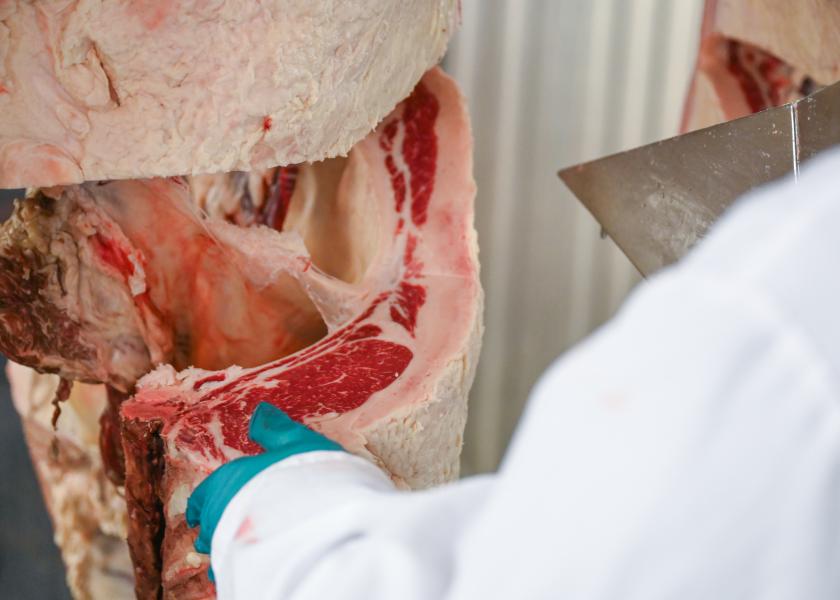Brand Specifications Evolve

“Meat heads” by education and experience, scientists and number crunchers gather to analyze the latest scatter plot. Coffee fuels the banter as they discuss where the figures point toward progress.
It’s Friday morning: analysis day for the Certified Angus Beef ® (CAB®) brand packing team.
Meat scientist Daniel Clark brings a new scatter plot each week, along with a fresh perspective to answer last week’s questions.
More than 2.6 million points fill the screen, each dot measuring how carcasses meet the 10 brand quality specifications — providing insight for possible improvement. How could adjustments help a premium supply meet the growing demand?
Changes don’t happen overnight.
The brand’s integrity is tied to these specifications, so they don’t evolve without careful consideration.
“The first question we ask,” Clark says, “is how it will affect our partners up and down the supply chain.”
Beyond the grading stand
On September 9, 2020, CAB will implement two changes to its “G1 schedule” specifications.
The first, a subtle rewording, adjusts the fat thickness limit from “less than 1 inch” to read “1 inch or less.” It might sound the same, but that precise language allows USDA graders more accurate measurements. Camera grading calculates fat thickness to several decimal places and that provides consistency and clarity when dealing with fractions of an inch.
The second change allows packers with an “extended licensing agreement” to box beef from some primals that met all quality specifications, but exceed the ribeye area, up to 19-square inches.
Ribs, ribeyes, strip loins and short loins from these carcasses will be excluded from the brand.
“This is not an expansion of the ribeye area to 19-square inches, but rather capitalizing on other parts of the carcass that are practically unaffected by that limit,” says Clint Walenciak, CAB director of packing.
The move allows foodservice and retail partners to access CAB briskets, tenderloins, short ribs and end meats for roasts and ground beef from those carcasses that fall in the 16- to 19-square include ribeye. The exclusion of larger ribeyes, ribs, strip and short loins, maintains brand-quality plate presentations and thicker cuts for the key middle-meat items. Box quality, consistency and center-of-the-plate steak presentation standards remain the same.
“I don’t want to overstate the magnitude of the expanded specification, but it is one small step in one big direction,” Clark says. “This is exciting for the future of the brand and for our partners on all fronts.”
Their research shows the size differentiation of cuts entering the box from the carcasses with a larger ribeye will have little to no impact on the size or weight of the box.
“The expanded product specification is voluntary for packers, and may be incorporated when timing is right to satisfy customer demand on a plant-by-plant basis,” Walenciak says.
Until a packer implements this change, its impact on premiums and discounts is uncertain.
Cattlemen should not take their eye off of ribeye size, Walenciak says. While this innovation creates potential access to additional high-quality cattle, demand pressure for 10 to 16 square-inch ribeyes remains.
Next Friday, the packing team will evaluate data again, searching for new clues on how to make the best even better.
It’s a team effort to crunch the numbers, balance the science and calculate the scope of possible adjustments. Never sacrificing quality, the ongoing process can evolve the specifications if that raises the standard, says Bruce Cobb, CAB executive vice president of production.

“Making those cattle more valuable, these specification expansions help the brand gain strength and footprint on the market path to two billion pounds of supply annually,” he says.
The focus remains on fulfilling demand and creating economic incentives for cattlemen and all supply chain partners.
“We are working toward a vision where this brand supplies more of the best that Angus cattlemen create,” Cobb says. “This is one small step forward to creating an ever-better beef production system.”
Progress is a process that happens one dataset, conversation and cup of coffee at a time.
The 10 Science-based Specifications:
To earn the Certified Angus Beef ® logo, Angus-influenced cattle with a predominantly solid black coat must pass its 10 quality standards:
Marbling
1. Modest or higher marbling – the single largest barrier to CAB acceptance, this ensures superior flavor and juiciness.
2. Medium or fine marbling texture – many small flecks of fat as opposed to larger, coarser characteristics. Creates consistency in every bite.
Maturity
3. 30 months of age or younger – ensures superior color, texture and tenderness
Consistent sizing
Three specifications ensure thicker steaks and consistent plate presentations:
4. 10- to 16-square-inch ribeye area*
5. 1,050-pound or less hot carcass weight
6. 1 inch or less fat thickness
Plate presentation
7. Superior muscling limits light-muscled cattle – reduces influence of dairy-type cattle with inconsistent yields and plate presentation
Quality appearance and tenderness
8. Practically free of capillary rupture – ensures quality appearance
9. No dark cutters – ensures consistent appearance and flavorw
10. No neck hump exceeding 2 inches – safeguards against Brahman-influence cattle, which have more variation in tenderness
*Up to 19 square inches for ribeye area is acceptable for tenderloin, brisket, thin meat, chuck and round cuts at approved plants. Rib, ribeye, strip loin and short loin are excluded from this option.







